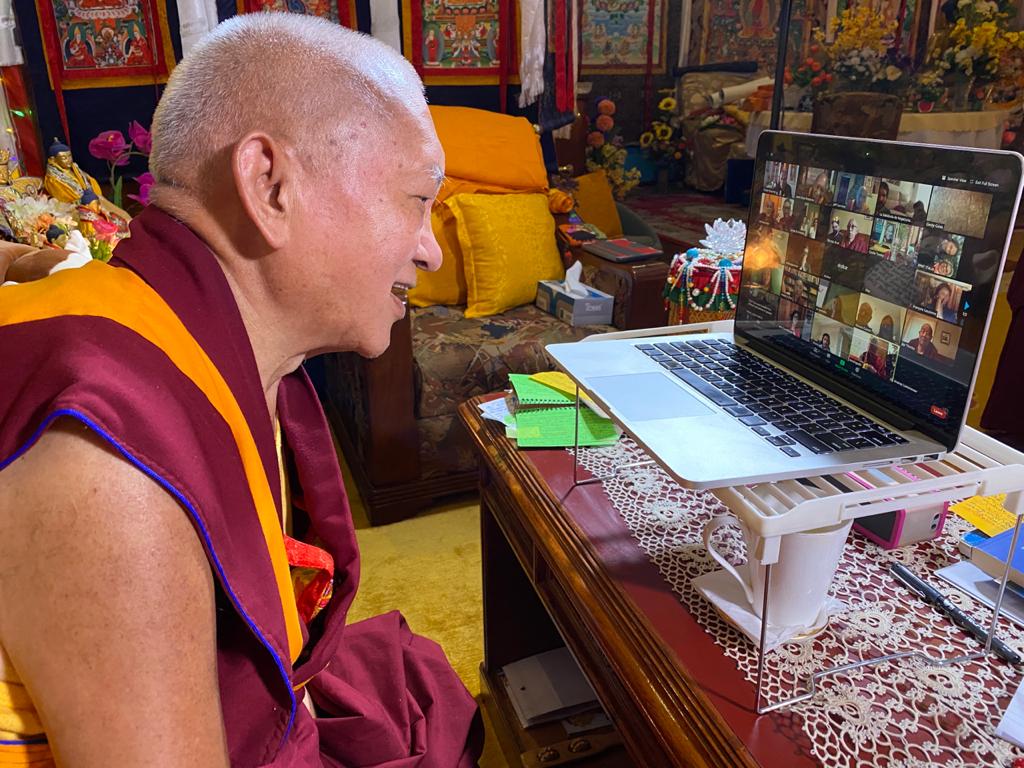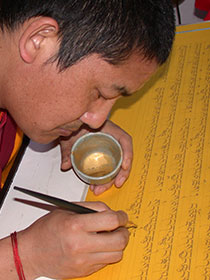
Microfilm for Stupas and Prayer Wheels
What Is Microfilm?
Microfilm is an analog storage medium using film reels that are exposed and developed into photographic records using a photographic process. Microfilm is an actual film, like the film on a regular camera. The microfilm used for the purpose of the Mani and other mantras is 16mm wide (5/8 of an inch), thinner than camera film. Microfilm cameras have the ability to take an original document as large as legal size (11×14 inches) and reduce the image to 16mm by 10mm on the microfilm. Then when the microfilm is processed (in the same manner as black and white film is processed), the images come out clearly in black and white and microscopic on the film. A microfilm reader is used to read the images on the microfilm. The film is placed into a certain slot and fed through a light and magnifier that produces the image onto a screen in front of the viewer, but in the case of mantras our images are so small that a microscope is needed to read the mantras. Microfilm is primarily used by libraries and the government to store and archive documents and periodicals.
We are currently providing certain mantra files as well as prayers and sutras specifically for replication on microfilm. The film is designed for the purpose of filling prayer wheels, stupas and statues with the maximum number of mantras, prayers, and sutras possible. Currently we have OM MANI PADME HUM as well as many other mantras available for replication on microfilm. Each file has a different number of mantras on it. For example, 2,000 feet of OM MANI PADME HUM on microfilm contains 685,809,230 mantras. The master file for this microfilm took several months to complete, using the best technology available in order to create the clearest images possible. These master rolls have the most mantras that can be put onto microfilm while maintaining the best quality – Lama Zopa Rinpoche advises that the mantras must be perfectly legible at any magnification for the microfilm to be suitable to be used to fill prayer wheels and stupas.
Here is the list of number of mantras per 2,000 foot roll:
- Chenrezig Mani Mantra (OM MANI PADME HUM): 685,809,230 per 2000 foot roll
- Longest Chenrezig Mantra 425,397 per 2000 foot roll
- Four Dharmakaya Relic Mantras 185,089 per 2000 foot roll, with individual mantra numbers as follows (Stainless Pinnacle, Tsugtor Drime: 185,089; Zung of the Exalted Completely Pure Stainless Light: 185,089; Secret Relic: 185,089; 100,000 Ornaments: 185,089)
- Padmasambhava (Guru Rinpoche) Mantra: 28,966,617 per 2000 foot roll
- Five Powerful Deity Mantras: 1,849,807 per 2000 foot roll, with individual mantra numbers as follows (Mitrugpa: 369,961; Stainless Pinnacle: 246,641; Kunrig: 123,320; Namgyalma: 493,282; Lotus Pinnacle of Amogapasha: 616,602)
- Amitayus Long Life Sutra: 53,352 per 2000 foot roll
- Namgyalma Mantra: approximately 1,116,000 per 2000 foot roll
- Zung of the Exalted Completely Pure Stainless Light: approximately 2,170,000 per 2000 foot roll
- Kunrig Mantra: TBD
- Stainless Pinnacle, Tsugtor Drime: 3,038,000 per 2000 foot roll
- Kurukulla Mantra: 44,909,235 per 2000 foot roll
- Dependent Related Heart Mantra: 12,303,900 per 2000 foot roll
The information here relates to the master microfilm files developed by FPMT Education Services. For a complete list of all microfilm available, please contact Buddhist Microfilm.
Microfilm comes in 2,000 foot rolls and is 9 and 2/16 inches across and 5/8 inches wide. The film weighs approximately 2 pounds a roll. Microfilm of any of the mantras, prayers or sutras listed below can be ordered by visiting the microfilm website www.buddhistmicrofilmmantras.com with your request.
Microfilm can last over 100 years before any deterioration is detected. This is under optimal conditions, which means keeping the microfilm in a cool, dry, dark place. For prayer wheels, it is very important to consider what the conditions in the interior of the prayer wheel will be like. Microfilm will melt under extremely hot conditions if the film is touching the hot metal on the inside walls of a prayer wheel that is standing in direct sun. If metal prayer wheels are constructed with the intention to hold microfilm they need to be insulated and ideally have a shelter over them to protect them from heat. You can use fiberglass or foam insulation, even wool or newspaper will work.
If a prayer wheel is going to be constructed in very humid conditions, make sure to wind the film tight so that moisture does not get in between the layers of film. If there is space in between the film layers as it is being wound then moisture will seep into the gaps and could form mold. To prevent this, the film must be wound tightly around itself and a layer of absorbent material should insulate the prayer wheel interior. With these precautions your film should be fine.
If these problems are avoided, the film should last a minimum of 100 years.
It is important to determine the correct direction of the film so that the mantras can be wound going clockwise around the central shaft, meaning the beginning of the mantra should be going first and the end last. We now have indicators on our micro film. All indicators are at the beginning of the film and say the name of the film in readable-to-the-naked-eye size text.
If you are working at an FPMT center and Lama Zopa Rinpoche has requested you to put certain mantras and texts onto film for your prayer wheel or stupa, you may email your request to Education Services at FPMT International Office. Education Services will provide the mantras and texts you need to take to the microfilm company who will then make the film. Any mantra or text you have been requested to put in your stupa or prayer wheel needs to be reduced and altered in order to fit as many images as possible onto the film while maintaining perfect clarity.









